Hybrid Fuzzy AHP and Frequency Ratio Methods for Assessing Flood Susceptibility in Bayech Basin, Southwestern Tunisia
Abstract
:1. Introduction
2. Materials and Methods
2.1. Study Area
2.2. Flood Condition Parameters
2.2.1. Elevation
2.2.2. Drainage Density
2.2.3. Soil Texture
2.2.4. Slope
2.2.5. Distance from the River
2.2.6. Land Use
2.2.7. Rainfall
2.3. Fuzzy Analytical Hierarchy Process (F-AHP)
2.4. Frequency Ratio Model (FR)
2.5. Flood Inventory Map
Validation
3. Results
4. Discussion
5. Conclusions
Author Contributions
Funding
Institutional Review Board Statement
Informed Consent Statement
Data Availability Statement
Acknowledgments
Conflicts of Interest
Appendix A
| Source (s) | [10] | [11] | [12] | [13] | [14] | [15] | [16] | [17] | |
| Name of|the Attribute | |||||||||
| Rainfall | × | × | × | × | × | × | × | × | |
| Elevation | × | × | × | × | × | × | × | × | |
| Land use/Land cover | × | × | × | × | × | × | × | × | |
| Drainage density | × | × | × | × | × | × | × | × | |
| Soil Moisture Index | × | ||||||||
| NDVI | × | ||||||||
| Hydraulic conductivity | × | ||||||||
| Flow accumulation | × | ||||||||
| Slope | × | × | × | × | × | × | × | × | |
| Groundwater level | × | × | |||||||
| Soil | × | × | × | × | × | ||||
| Curvature | × | ||||||||
| Stream power index | × | ||||||||
| Topographic wetness index | × | × | × | ||||||
| Geology | × | × | × | × | × | × | |||
| Distance from the river | × | × | × | × | × | × | |||
References
- Elahi, E.; Khalid, Z.; Tauni, M.Z.; Zhang, H.; Lirong, X. Extreme weather events risk to crop-production and the adaptation of innovative management strategies to mitigate the risk: A retrospective survey of rural Punjab, Pakistan. Technovation 2022, 117, 102255. [Google Scholar] [CrossRef]
- Abbas, A.; Waseem, M.; Ahmad, R.; Khan, K.A.; Zhao, C.; Zhu, J. Sensitivity analysis of greenhouse gas emissions at farm level: Case study of grain and cash crops. Environ. Sci. Pollut. Res. 2022, 29, 82559–82573. [Google Scholar] [CrossRef]
- Wang, Y.; Xiao, D.; Li, Y.; Li, X. Soil salinity evolution and its relationship with dynamics of groundwater in the oasis of inland river basins: Case study from the Fubei region of Xinjiang Province, China. Environ. Monit. Assess. 2008, 140, 291–302. [Google Scholar] [CrossRef] [PubMed]
- Vaidya, O.S.; Kumar, S. Analytic hierarchy process: An overview of applications. Eur. J. Oper. Res. 2006, 169, 1–29. [Google Scholar] [CrossRef]
- Chang, D.-Y. Applications of the extent analysis method on fuzzy AHP. Eur. J. Oper. Res. 1996, 95, 649–655. [Google Scholar] [CrossRef]
- Balezentiene, L.; Streimikiene, D.; Balezentis, T. Fuzzy decision support methodology for sustainable energy crop selection. Renew. Sustain. Energy Rev. 2013, 17, 83–93. [Google Scholar] [CrossRef]
- Tian, J.; Yan, Z.F. Fuzzy Analytic Hierarchy Process for Risk Assessment to General-assembling of Satellite. J. Appl. Res. Technol. 2013, 11, 568–577. [Google Scholar] [CrossRef]
- Samanta, S.; Pal, D.K.; Palsamanta, B. Flood susceptibility analysis through remote sensing, GIS and frequency ratio model. Appl. Water Sci. 2018, 8, 66. [Google Scholar] [CrossRef]
- Tehrany, M.S.; Kumar, L.; Jebur, M.N.; Shabani, F. Evaluating the application of the statistical index method in flood susceptibility mapping and its comparison with frequency ratio and logistic regression methods. Geomat. Nat. Hazards Risk 2019, 10, 79–101. [Google Scholar] [CrossRef]
- Khadraoui, N.; Dahri, N.; Bouamrane, A.; Pham, Q.B.; Abida, H. Flood susceptibility mapping using qualitative and statistical methods in a semi-arid basin: Case of the Manouba–Sijoumi watershed, Northeastern Tunisia. Acta Geophys. 2022. [Google Scholar] [CrossRef]
- Talha, S.; Maanan, M.; Atika, H.; Rhinane, H. Prediction of flash flood susceptibility using fuzzy analytical hierarchy process (f-ahp) algorithms and gis: A study case of guelmim region in southwestern of Morocco. Int. Arch. Photogramm. Remote Sens. Spat. Inf. Sci. 2019, XLII-4/W19, 407–414. [Google Scholar] [CrossRef]
- Pradhan, B.; Mansor, S.; Pirasteh, S.; Buchroithner, M.F. Landslide hazard and risk analyses at a landslide prone catchment area using statistical based geospatial model. Int. J. Remote Sens. 2011, 32, 4075–4087. [Google Scholar] [CrossRef]
- Fehri, N.; Samaali, H.; Abaza, K. Les inondations catastrophiques du 13 octobre 2007 dans le secteur de Sabbelet Ben Ammar: Entre aléa climatique et responsabilité anthropique. Rev. Tunis. Géographie 2009, 40, 31–55. [Google Scholar]
- Fehri, N. L’aggravation du risque d’inondation en Tunisie: Éléments de réflexion. Physio-Géo Géographie Phys. Environ. 2014, 8. [Google Scholar] [CrossRef]
- Inondations en Tunisie: La Vigilance Est de Mise! Available online: https://www.businessnews.com.tn/inondations-en-tunisie--la-vigilance-est-de-mise,519,83213,3 (accessed on 26 July 2023).
- Mohamed, S.A.; El-Raey, M.E. Vulnerability assessment for flash floods using GIS spatial modeling and remotely sensed data in El-Arish City, North Sinai, Egypt. Nat. Hazards 2020, 102, 707–728. [Google Scholar] [CrossRef]
- Dahri, N.; Abida, H. Causes and impacts of flash floods: Case of Gabes City, Southern Tunisia. Arab. J. Geosci. 2020, 13, 176. [Google Scholar] [CrossRef]
- SKachouri; Achour, H.; Abida, H.; Bouaziz, S. Soil erosion hazard mapping using Analytic Hierarchy Process and logistic regression: A case study of Haffouz watershed, central Tunisia. Arab. J. Geosci. 2015, 8, 4257–4268. [Google Scholar] [CrossRef]
- Dahri, N.; Abida, H. Monte Carlo simulation-aided analytical hierarchy process (AHP) for flood susceptibility mapping in Gabes Basin (southeastern Tunisia). Environ. Earth Sci. 2017, 76, 302. [Google Scholar] [CrossRef]
- Tien Bui, D.; Shirzadi, A.; Shahabi, H.; Chapi, K.; Omidavr, E.; Pham, B.T.; Talebpour Asl, D.; Khaledian, H.; Pradhan, B.; Panahi, M.; et al. A Novel Ensemble Artificial Intelligence Approach for Gully Erosion Mapping in a Semi-Arid Watershed (Iran). Sensors 2019, 19, 2444. [Google Scholar] [CrossRef]
- Rajib, A.; Liu, Z.; Merwade, V.; Tavakoly, A.A.; Follum, M.L. Towards a large-scale locally relevant flood inundation modeling framework using SWAT and LISFLOOD-FP. J. Hydrol. 2020, 581, 124406. [Google Scholar] [CrossRef]
- Falah, F.; Nejad, S.G.; Rahmati, O.; Daneshfar, M.; Zeinivand, H. Applicability of generalized additive model in groundwater potential modelling and comparison its performance by bivariate statistical methods. Geocarto Int. 2017, 32, 1069–1089. [Google Scholar] [CrossRef]
- Ullah, K.; Zhang, J. GIS-based flood hazard mapping using relative frequency ratio method: A case study of Panjkora River Basin, eastern Hindu Kush, Pakistan. PLoS ONE 2020, 15, e0229153. [Google Scholar] [CrossRef]
- Rahmati, O.; Melesse, A.M. Application of Dempster–Shafer theory, spatial analysis and remote sensing for groundwater potentiality and nitrate pollution analysis in the semi-arid region of Khuzestan, Iran. Sci. Total Environ. 2016, 568, 1110–1123. [Google Scholar] [CrossRef] [PubMed]
- Fernández, D.S.; Lutz, M.A. Urban flood hazard zoning in Tucumán Province, Argentina, using GIS and multicriteria decision analysis. Eng. Geol. 2010, 111, 90–98. [Google Scholar] [CrossRef]
- Alexakis, D.D.; Grillakis, M.; Koutroulis, A.; Agapiou, A. GIS and remote sensing techniques for the assessment of land use change impact on flood hydrology: The case study of Yialias basin in Cyprus. Nat. Hazards Earth Syst. Sci. 2014, 14, 413–426. [Google Scholar] [CrossRef]
- Al-shabeeb, A.R. The Use of AHP within GIS in Selecting Potential Sites for Water Harvesting Sites in the Azraq Basin—Jordan. J. Geogr. Inf. Syst. 2016, 8, 73–88. [Google Scholar] [CrossRef]
- Akay, H. Flood hazards susceptibility mapping using statistical, fuzzy logic, and MCDM methods. Soft Comput. 2021, 25, 9325–9346. [Google Scholar] [CrossRef]
- Dubois, D. Evaluation and decision models: A critical perspective. Fuzzy Sets Syst. 2003, 139, 469–472. [Google Scholar] [CrossRef]
- Mikhailov, L. Deriving priorities from fuzzy pairwise comparison judgements. Fuzzy Sets Syst. 2003, 134, 365–385. [Google Scholar] [CrossRef]
- Baalousha, H.M.; Younes, A.; Yassin, M.A.; Fahs, M. Comparison of the Fuzzy Analytic Hierarchy Process (F-AHP) and Fuzzy Logic for Flood Exposure Risk Assessment in Arid Regions. Hydrology 2023, 10, 136. [Google Scholar] [CrossRef]
- Lee, S.; Pradhan, B. Probabilistic landslide hazards and risk mapping on Penang Island, Malaysia. J. Earth Syst. Sci. 2006, 115, 661–672. [Google Scholar] [CrossRef]
- Mersha, T.; Meten, M. GIS-based landslide susceptibility mapping and assessment using bivariate statistical methods in Simada area, northwestern Ethiopia. Geoenvironmental Disasters 2020, 7, 20. [Google Scholar] [CrossRef]
- Khosravi, K.; Nohani, E.; Maroufinia, E.; Pourghasemi, H.R. A GIS-based flood susceptibility assessment and its mapping in Iran: A comparison between frequency ratio and weights-of-evidence bivariate statistical models with multi-criteria decision-making technique. Nat. Hazards 2016, 83, 947–987. [Google Scholar] [CrossRef]
- Falah, F.; Rahmati, O.; Rostami, M.; Ahmadisharaf, E.; Daliakopoulos, I.N.; Pourghasemi, H.R. Artificial Neural Networks for Flood Susceptibility Mapping in Data-Scarce Urban Areas. In Spatial Modeling in GIS and R for Earth and Environmental Sciences; Elsevier: Amsterdam, The Netherlands, 2019; pp. 323–336. [Google Scholar] [CrossRef]
- Tehrany, M.S.; Pradhan, B.; Jebur, M.N. Spatial prediction of flood susceptible areas using rule based decision tree (DT) and a novel ensemble bivariate and multivariate statistical models in GIS. J. Hydrol. 2013, 504, 69–79. [Google Scholar] [CrossRef]
- Nachappa, T.G.; Piralilou, S.T.; Gholamnia, K.; Ghorbanzadeh, O.; Rahmati, O.; Blaschke, T. Flood susceptibility mapping with machine learning, multi-criteria decision analysis and ensemble using Dempster Shafer Theory. J. Hydrol. 2020, 590, 125275. [Google Scholar] [CrossRef]
- Bouamrane, A.; Bouamrane, A.; Abida, H. Water erosion hazard distribution under a Semi-arid climate Condition: Case of Mellah Watershed, North-eastern Algeria. Geoderma 2021, 403, 115381. [Google Scholar] [CrossRef]
- Hategekimana, Y.; Yu, L.; Nie, Y.; Zhu, J.; Liu, F.; Guo, F. Integration of multi-parametric fuzzy analytic hierarchy process and GIS along the UNESCO World Heritage: A flood hazard index, Mombasa County, Kenya. Nat. Hazards 2018, 92, 1137–1153. [Google Scholar] [CrossRef]
- Souissi, D.; Zouhri, L.; Hammami, S.; Msaddek, M.H.; Zghibi, A.; Dlala, M. GIS-based MCDM–AHP modeling for flood susceptibility mapping of arid areas, southeastern Tunisia. Geocarto Int. 2019, 35, 991–1017. [Google Scholar] [CrossRef]

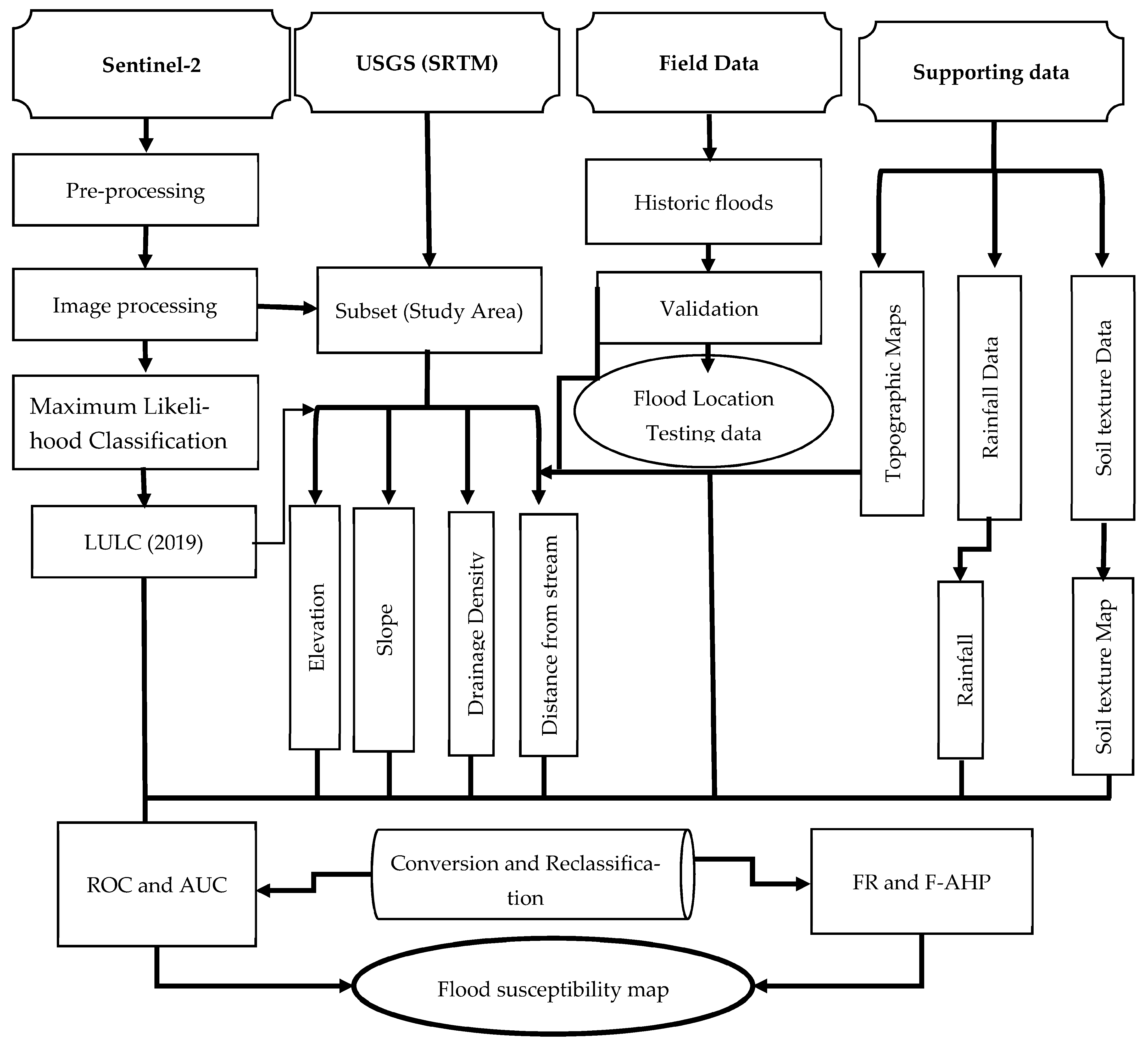
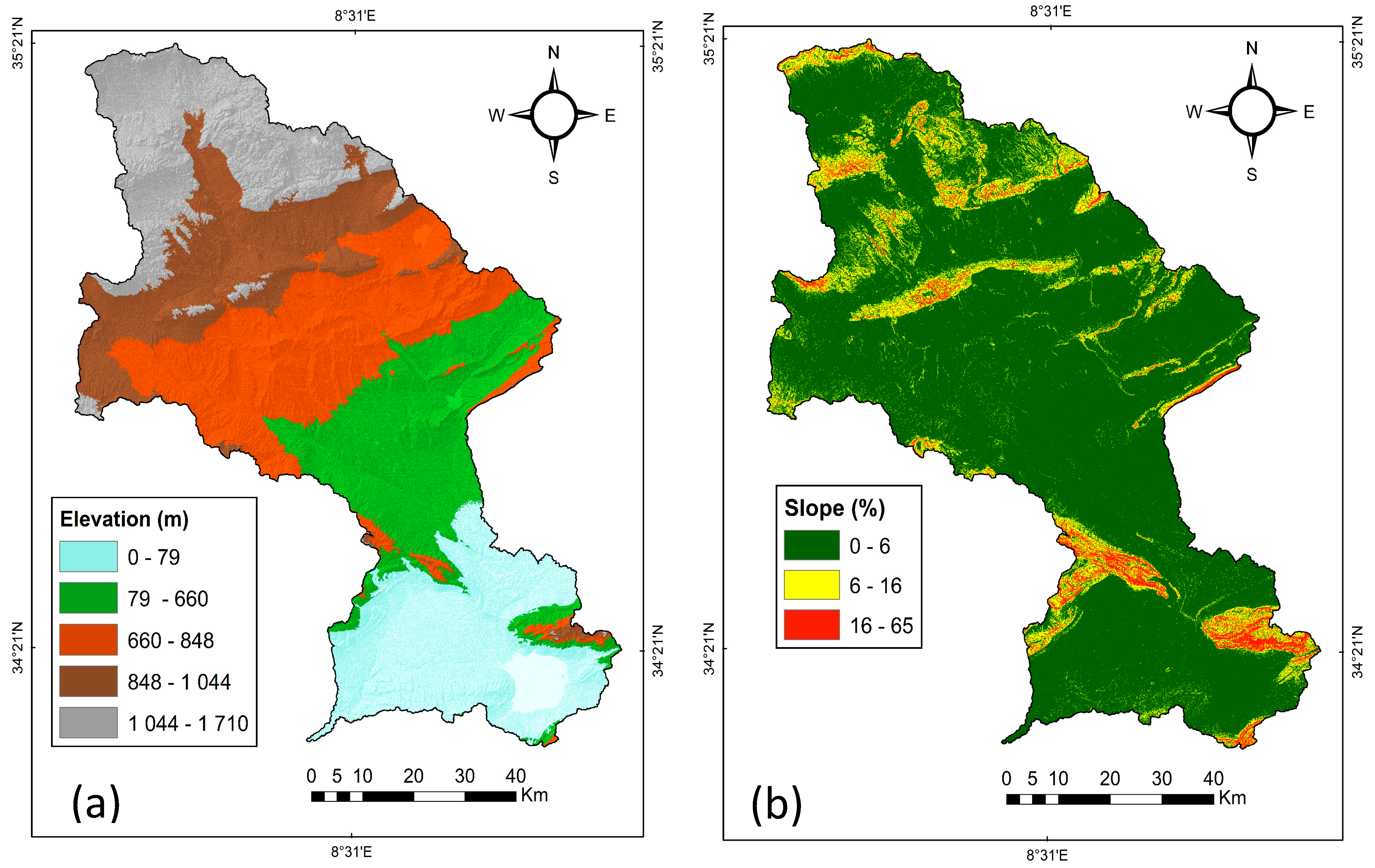
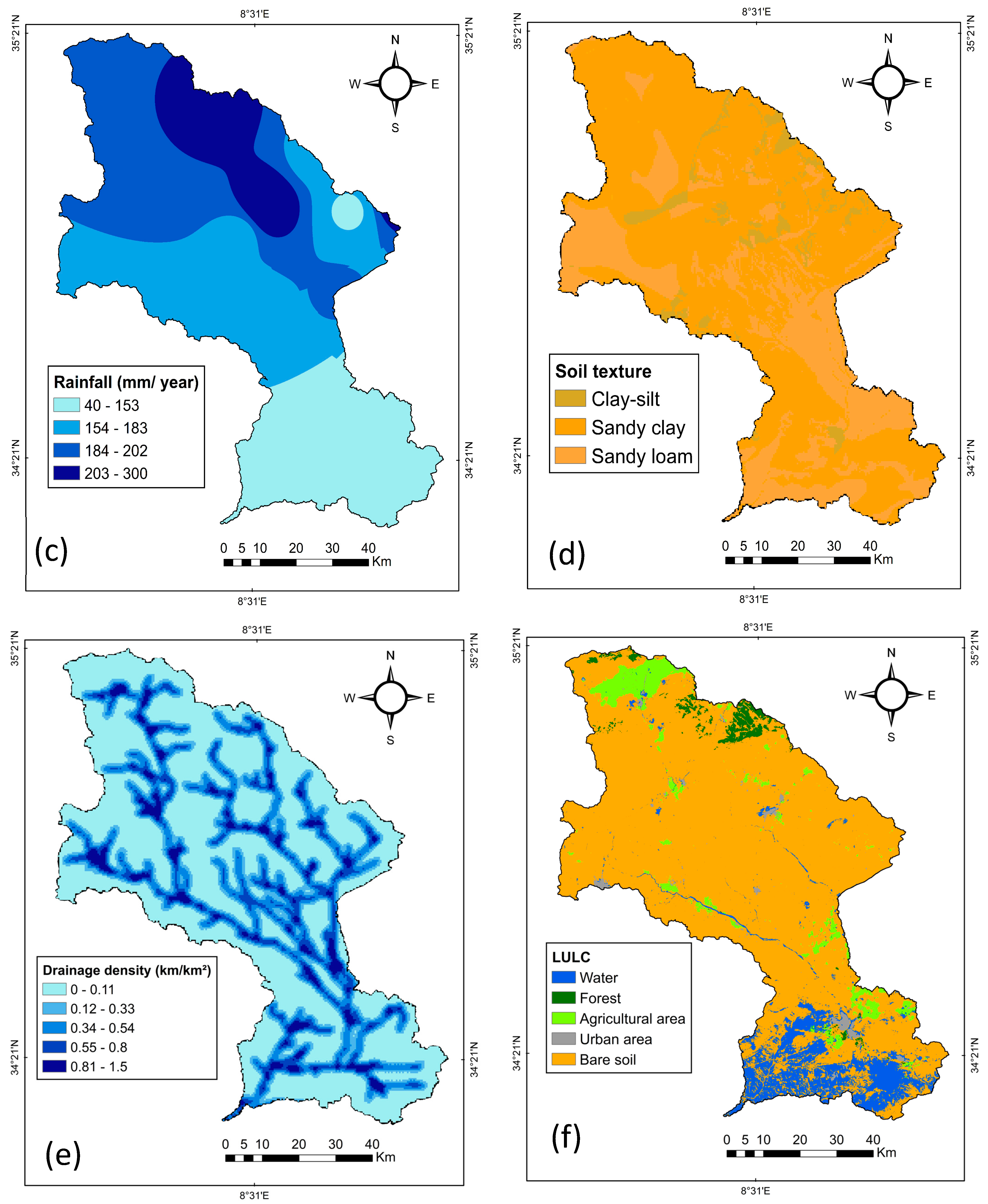
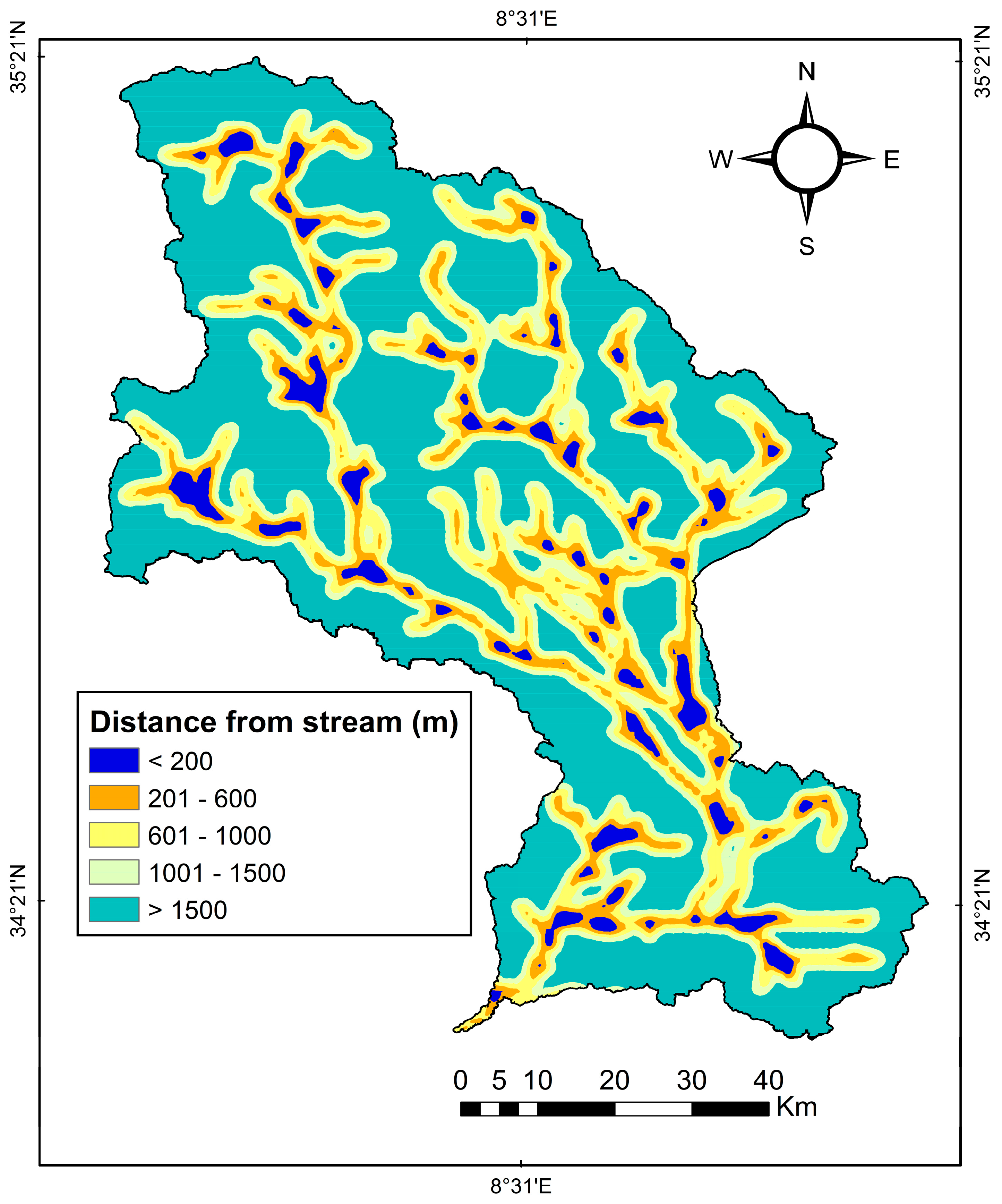
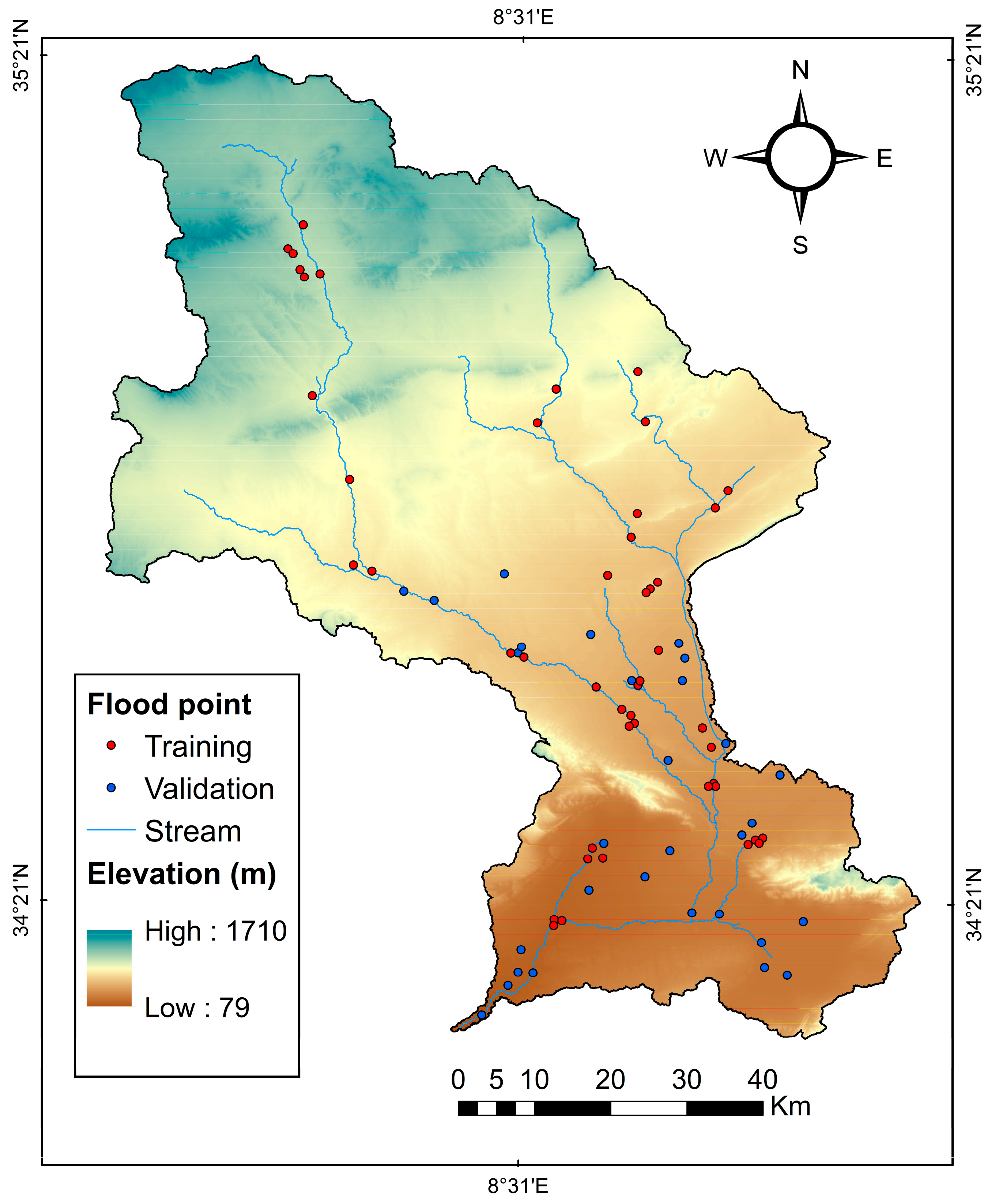
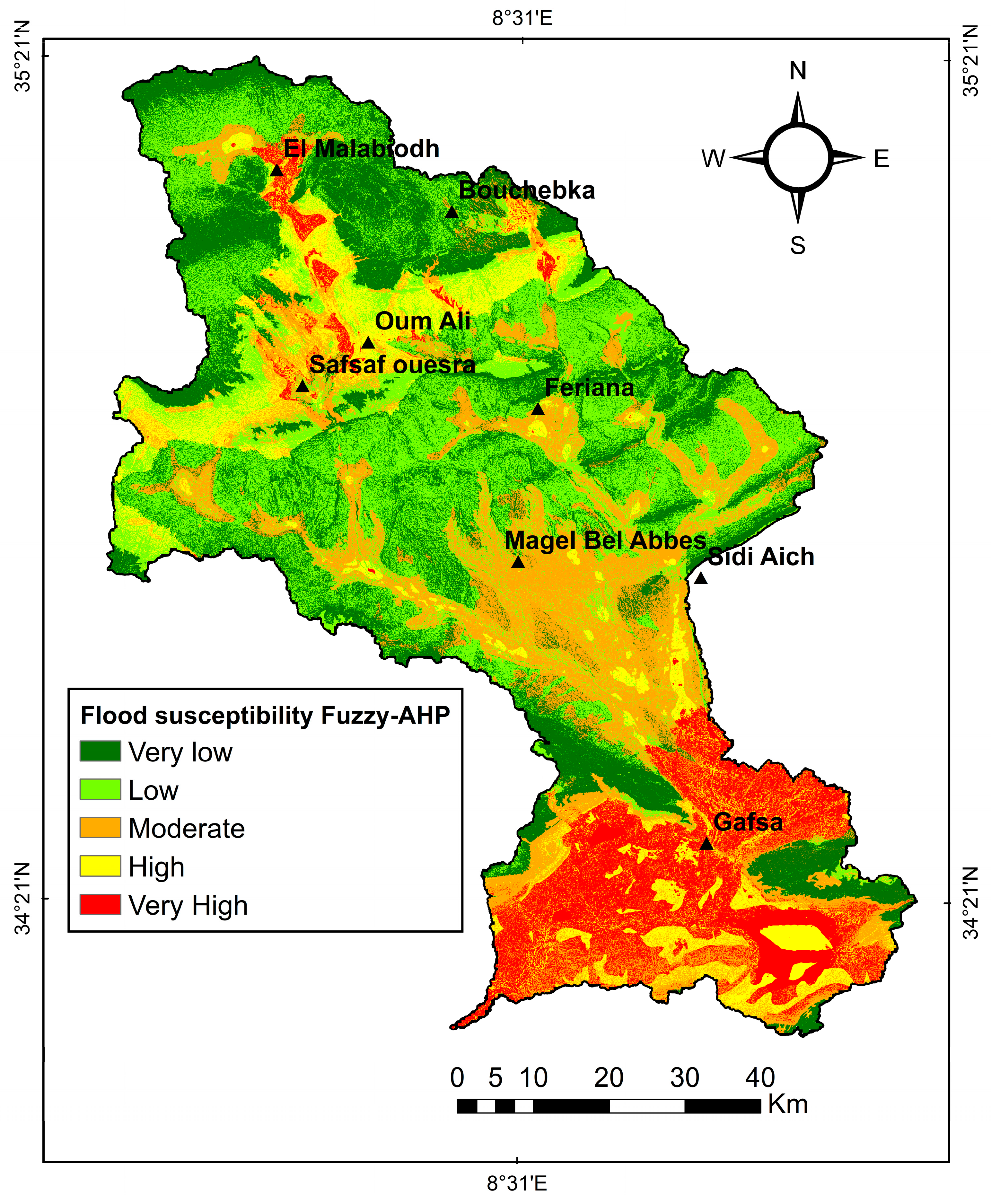
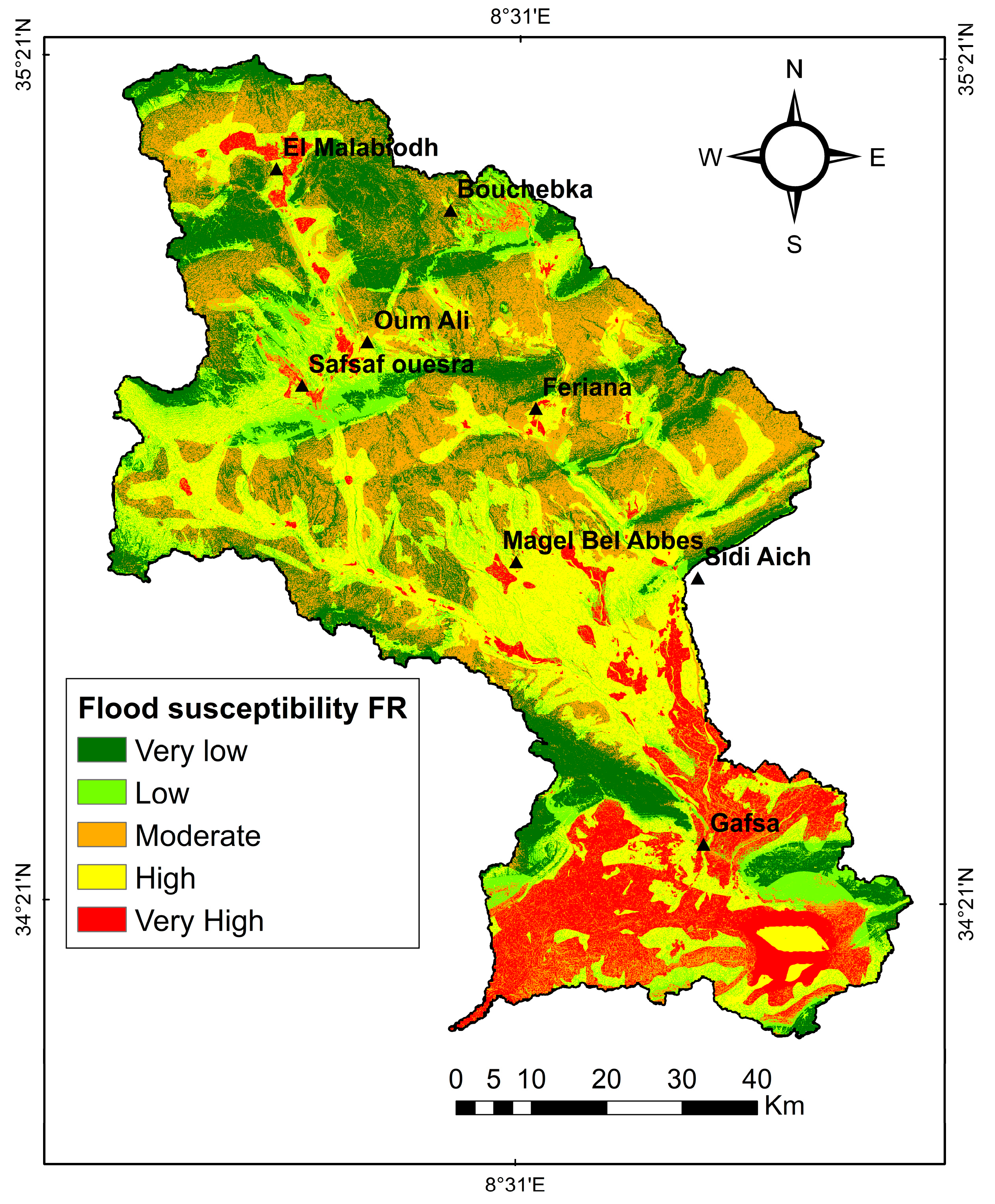
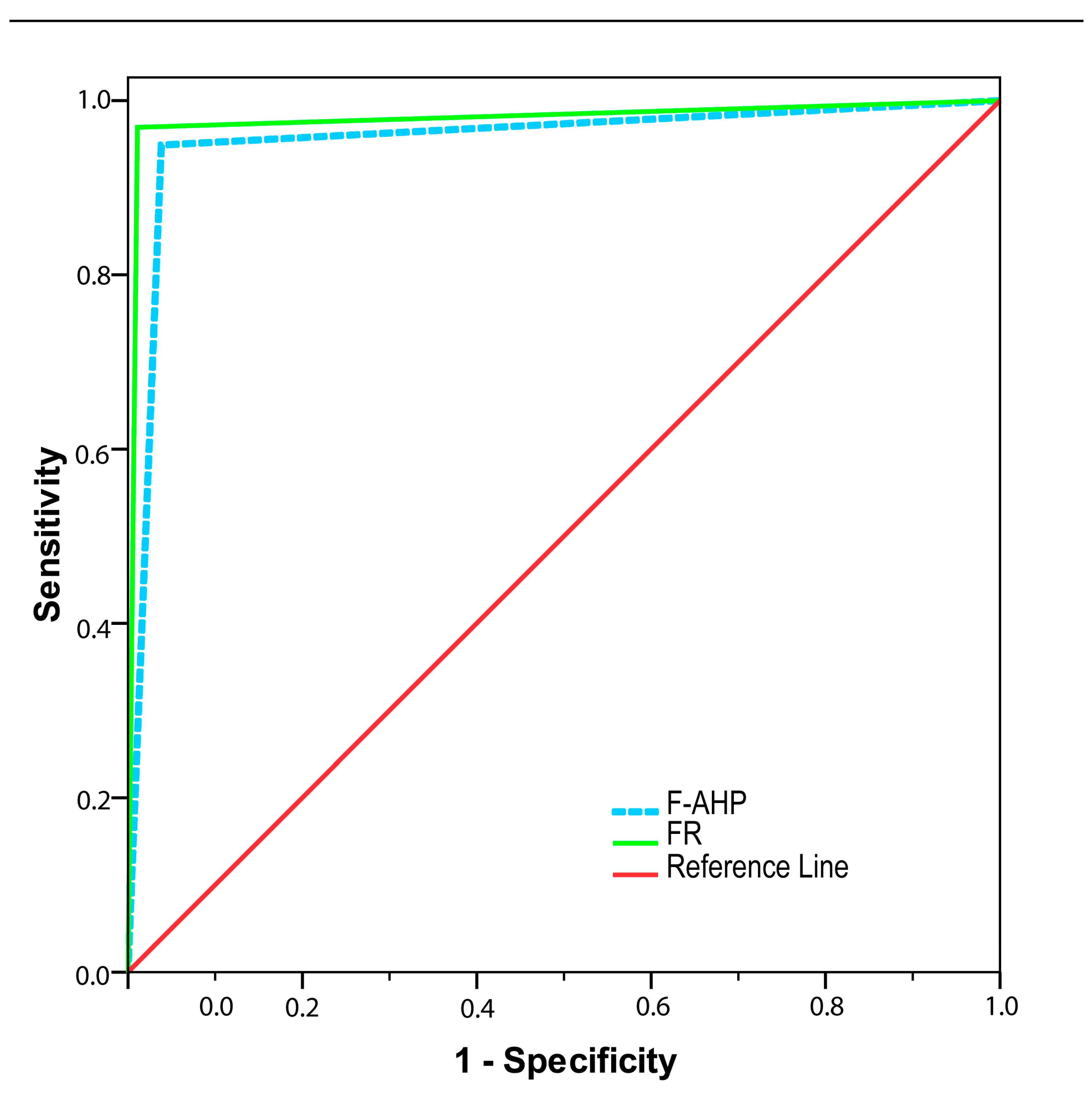
| Data | Spatial Resolution/Scale | Source | Criteria |
|---|---|---|---|
| Digital Elevation Model (DEM) | 30 m | USGS (https://earthexplorer.usgs.gov (accessed on 21 March 2021)) | - Hydrographic network - Distance from the river - Elevation - Slope - Drainage density |
| Remote sensing (Sentinel-2) | 10 m | Copernicus https://scihub.copernicus.eu (accessed on 21 March 2021) | - Land Use and Land Cover (LULC) |
| Lithology | 1:50,000 | CRDA of Gafsa | - Soil |
| Rainfall | 1:100,000 | CRDA of Gafsa and Kasserine (Spatial Interpolation of Rainfall Data) | - Rainfall distribution |
| Decades | Mean (mm) | Max (mm) | Min (mm) | Standard Deviation (mm) |
|---|---|---|---|---|
| 1980s | 154 | 297 | 72 | 64 |
| 1990s | 207 | 348 | 74 | 70 |
| 2000s | 183 | 283 | 105 | 48 |
| 2010s | 163 | 294 | 61 | 65 |
| Image of Flood | Date | Place |
|---|---|---|
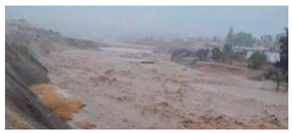 | 4 October 2017 | Gafsa |
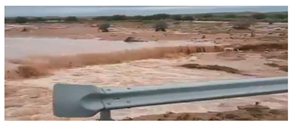 | 17 October 2018 | Feriana |
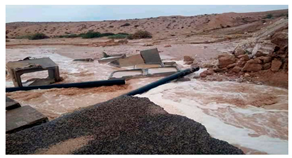 | 31 September 2019 | Gafsa |
| Fuzzy Number | Linguistic | Scale of Fuzzy Number |
|---|---|---|
| 9 | Perfect | (8,9,10) |
| 8 | Absolute | (7,8,9) |
| 7 | Very good | (6,7,8) |
| 6 | Fairly good | (5,6,7) |
| 5 | Good | (4,5,6) |
| 4 | Preferable | (3,4,5) |
| 3 | Not bad | (2,3,4) |
| 2 | Weak advantage | (1,2,3) |
| 1 | Equal | (1,1,1) |
| Criteria | Weight |
|---|---|
| Elevation | 0.391 |
| Drainage Density | 0.252 |
| Slope | 0.144 |
| Distance from river | 0.092 |
| Land use | 0.095 |
| Soil texture | 0.063 |
| Rainfall | 0.023 |
| Factor | Units | Factor Classes | FR | RF |
|---|---|---|---|---|
| Slope | (%) | 0–6 | 1.60 | 0.83 |
| 6–16 | 0.31 | 0.16 | ||
| 16–65 | 0.02 | 0.01 | ||
| Rainfall | mm/year | 203–300 | 2.19 | 0.50 |
| 184–202 | 0.95 | 0.21 | ||
| 154–183 | 1.06 | 0.24 | ||
| 40–153 | 0.21 | 0.05 | ||
| Drainage Density | km/km2 | 0–0.11 | 0.24 | 0.01 |
| 0.12–0.33 | 2.21 | 0.10 | ||
| 0.34–0.54 | 3.04 | 0.13 | ||
| 0.55–0.80 | 5.58 | 0.24 | ||
| 0.81–1.5 | 11.87 | 0.52 | ||
| Land use | -- | Agricultural area | 2.57 | 0.14 |
| Bare soil | 0.13 | 0.01 | ||
| Water | 8.25 | 0.45 | ||
| Urban area | 6.92 | 0.38 | ||
| Forest | 0.31 | 0.02 | ||
| Soil texture | -- | Clay-silt | 1.27 | 0.60 |
| Sandy clay | 0.52 | 0.25 | ||
| Sandy loam | 0.32 | 0.15 | ||
| Distance from Stream | m | >1500 | 0.05 | 0.01 |
| 1001–1500 | 1.07 | 0.10 | ||
| 601–1000 | 2.16 | 0.21 | ||
| 201–600 | 2.93 | 0.28 | ||
| <200 | 4.31 | 0.41 | ||
| Elevation | m | 0–79 | 3.53 | 0.46 |
| 79–660 | 0.95 | 0.12 | ||
| 660–848 | 0.29 | 0.04 | ||
| 848–1044 | 2.93 | 0.38 | ||
| 1044–1710 | 0.01 | 0.00 |
| Factor | PR Value |
|---|---|
| Slope | 2.66 |
| Rainfall | 1.46 |
| Drainage Density | 1.65 |
| Land use | 1.46 |
| Soil texture | 1.47 |
| Distance from Stream | 1.32 |
| Elevation | 1.49 |
| Variable | AUC | SE | 95% CI |
|---|---|---|---|
| F-AHP | 0.955 | 0.949 | 0.925 |
| FR | 0.979 | 0.969 | 0.957 |
Disclaimer/Publisher’s Note: The statements, opinions and data contained in all publications are solely those of the individual author(s) and contributor(s) and not of MDPI and/or the editor(s). MDPI and/or the editor(s) disclaim responsibility for any injury to people or property resulting from any ideas, methods, instructions or products referred to in the content. |
© 2023 by the authors. Licensee MDPI, Basel, Switzerland. This article is an open access article distributed under the terms and conditions of the Creative Commons Attribution (CC BY) license (https://creativecommons.org/licenses/by/4.0/).
Share and Cite
Ali, Z.; Dahri, N.; Vanclooster, M.; Mehmandoostkotlar, A.; Labbaci, A.; Ben Zaied, M.; Ouessar, M. Hybrid Fuzzy AHP and Frequency Ratio Methods for Assessing Flood Susceptibility in Bayech Basin, Southwestern Tunisia. Sustainability 2023, 15, 15422. https://doi.org/10.3390/su152115422
Ali Z, Dahri N, Vanclooster M, Mehmandoostkotlar A, Labbaci A, Ben Zaied M, Ouessar M. Hybrid Fuzzy AHP and Frequency Ratio Methods for Assessing Flood Susceptibility in Bayech Basin, Southwestern Tunisia. Sustainability. 2023; 15(21):15422. https://doi.org/10.3390/su152115422
Chicago/Turabian StyleAli, Zaineb, Noura Dahri, Marnik Vanclooster, Ali Mehmandoostkotlar, Adnane Labbaci, Mongi Ben Zaied, and Mohamed Ouessar. 2023. "Hybrid Fuzzy AHP and Frequency Ratio Methods for Assessing Flood Susceptibility in Bayech Basin, Southwestern Tunisia" Sustainability 15, no. 21: 15422. https://doi.org/10.3390/su152115422
APA StyleAli, Z., Dahri, N., Vanclooster, M., Mehmandoostkotlar, A., Labbaci, A., Ben Zaied, M., & Ouessar, M. (2023). Hybrid Fuzzy AHP and Frequency Ratio Methods for Assessing Flood Susceptibility in Bayech Basin, Southwestern Tunisia. Sustainability, 15(21), 15422. https://doi.org/10.3390/su152115422








